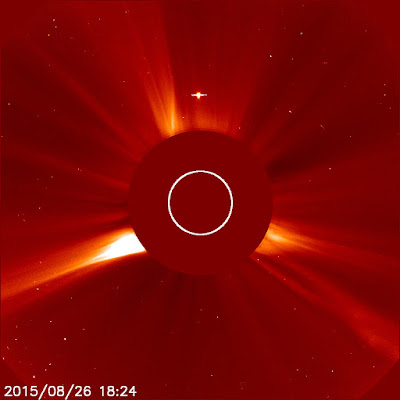Hello!
JUPITER TODAY is a daily blog about the dynamic Jupiter system for the purpose of monitoring activity.
We start with the overall view of activity with the Jupiter system, showing the orbits of the four Galilean moons:
This is a view of the Jupiter system looking down on it. Following the blue line
to the left is the line of sight to Earth, while following the gray line to the left is the line of sight
to the Sun. The orbits of the four Galilean moons are shown. The large
dots indicate the position of each moon at 0h, 6h, 12h, 18h, and 24h
(0h the next day) UTC for this date. From this point of view, the moons revolve around Jupiter
in a counter-clockwise motion. For more information about this graphic, see the post from 30 July 2015.
Jupiter has just now passed Superior Conjunction.
These images blow me away they are so incredibly beautiful. Here's the
current SOHO image showing the steady progress of Jupiter across its field of view:
Here is a view of the SC itself also as seen from the SOHO LASCO C2 camera:
The graph below shows the positions of the four Galilean moons over the
next 24 hours as seen from Earth. The curved lines show
the path of each moon through time. The dark band in the center is
Jupiter. The x-axis is the distance, in arc seconds, from the center of
Jupiter:
At 0h UTC, Io starts the day in quad 2 moving west. Europa starts the day in quad 1 heading east. Ganymede and Callisto spend all day in quad 2 heading west.
By 6h UTC, Io has transited Jupiter and is now in quad 3 moving west. Europa is at its eastern elongation and is now in quad 2 moving west.
At 12h UTC, Io is coming up on its western elongation and will be moving into quad 4 heading east. Europa is now firmly in quad 2 with Ganymede and Callisto heading west the rest of the day.
By 18h UTC, Io is past western elongation and is now firmly in quad 4 moving east.
At 0h UTC tomorrow, Io is moving behind Jupiter. Europa is about to transit Jupiter. Ganymede and Callisto continue in quad 2 moving west a little while longer.
At 02:21 UTC, Io goes through an apojove at a distance of 423,498.2 km. At 22:09 UTC, Ganymede goes through its perijove at at distance of 1,068,977.8 km. At 23:38 UTC, Io goes through its perijove at a distance of 420,030.1 km. At 23:47 UTC, Europa goes through its perijove at a distance of 664,504.4 km.
At 0h UTC, the position of Jupiter on Earth's celestial sphere is RA 10h 22m 28.8s, DEC +11d 05m 01.1s. The phase angle is 0.223 degrees, which is 0.059 degrees greater than yesterday. The angle between Jupiter and the Sun is now increasing and is at 1.191 degrees, which is 0.319 degrees greater than yesterday. The distance between Jupiter and the Sun is 806,092,199 km, which is 36,479 km greater than yesterday. Jupiter is moving away from the sun at a velocity of 1,519.958 km/h, which is 1.458 km/h faster than yesterday. The distance between Jupiter and Earth is 957,186,704 km, which is 15,116 less than yesterday. Jupiter and Earth are now moving toward one another at a velocity of 629.833 km/h, which is 1,282.458 km/h "slower" than yesterday.
From 02:56 to 05:14, the shadow of Io transits Jupiter. From 02:57 to 05:15, Io itself transits Jupiter.
Now the Orbital Ribbons:
Jupiter is so near Superior Conjunction that photography and other data collection isn't
practical. We'll have to wait about a months after SC to start viewing
the Jupiter system again.
Spread the word about this daily blog! This blog is subject to
evolution. What can I do to make this blog more interesting and more
informative?
Subscribe at the right column of this blog and get these posts sent to you automatically!
Please send me your feedback, comments, and questions to jupitertoday AT gmail DOT com or the comments section of this blog.
With my gratitude, the data used to create the orbit plots and ribbons was supplied by the JPL Horizons website. The graphics showing the location of the four moons as seen from Earth are via 'Jupiter Viewer 2.8'. Jupiter-Satellite and Satellite mutual events data is supplied from IMCEE.
Until tomorrow, I bid you Peace.




No comments:
Post a Comment